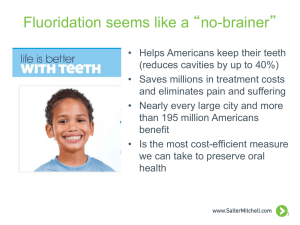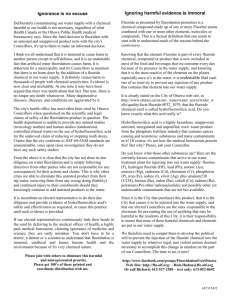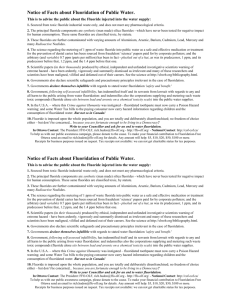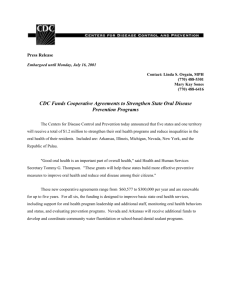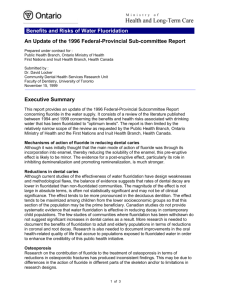Water Fluoridation in Canada: Past and Present
advertisement
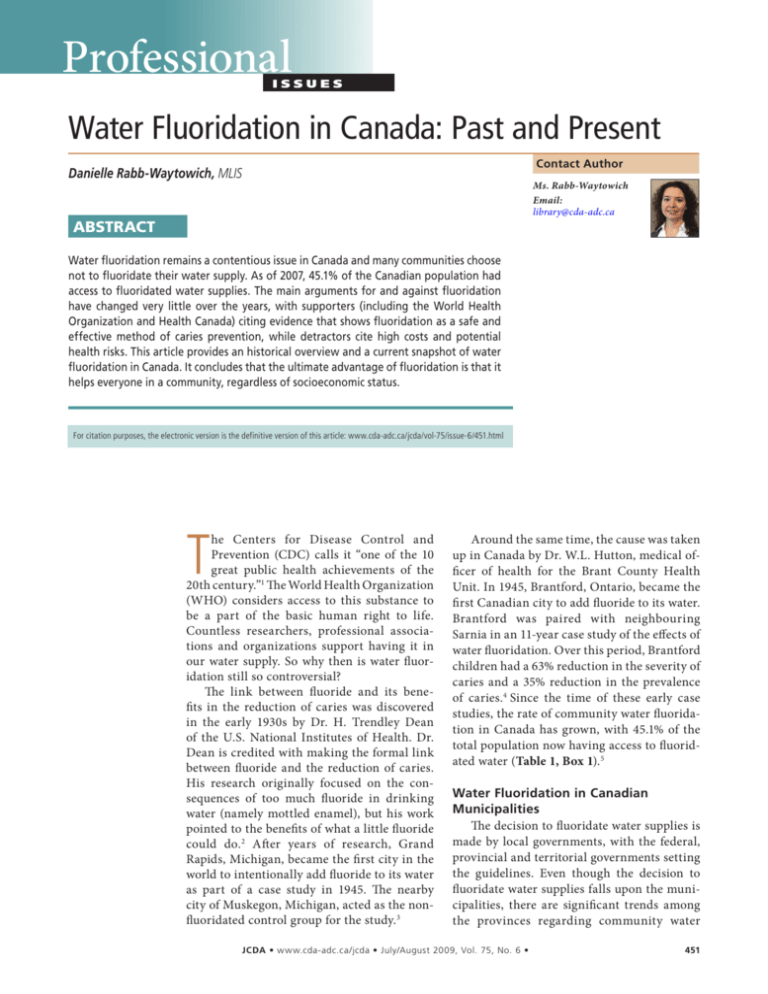
Professional Issues Water Fluoridation in Canada: Past and Present Contact Author Danielle Rabb-Waytowich, MLIS Ms. Rabb-Waytowich Email: library@cda-adc.ca ABSTRACT Water fluoridation remains a contentious issue in Canada and many communities choose not to fluoridate their water supply. As of 2007, 45.1% of the Canadian population had access to fluoridated water supplies. The main arguments for and against fluoridation have changed very little over the years, with supporters (including the World Health Organization and Health Canada) citing evidence that shows fluoridation as a safe and effective method of caries prevention, while detractors cite high costs and potential health risks. This article provides an historical overview and a current snapshot of water fluoridation in Canada. It concludes that the ultimate advantage of fluoridation is that it helps everyone in a community, regardless of socioeconomic status. For citation purposes, the electronic version is the definitive version of this article: www.cda-adc.ca/jcda/vol-75/issue-6/451.html T he Centers for Disease Control and Prevention (CDC) calls it “one of the 10 great public health achievements of the 20th century.”1 The World Health Organization (WHO) considers access to this substance to be a part of the basic human right to life. Countless researchers, professional associations and organizations support having it in our water supply. So why then is water fluoridation still so controversial? The link between fluoride and its benefits in the reduction of caries was discovered in the early 1930s by Dr. H. Trendley Dean of the U.S. National Institutes of Health. Dr. Dean is credited with making the formal link between fluoride and the reduction of caries. His research originally focused on the consequences of too much fluoride in drinking water (namely mottled enamel), but his work pointed to the benefits of what a little fluoride could do. 2 After years of research, Grand Rapids, Michigan, became the first city in the world to intentionally add fluoride to its water as part of a case study in 1945. The nearby city of Muskegon, Michigan, acted as the nonfluoridated control group for the study. 3 Around the same time, the cause was taken up in Canada by Dr. W.L. Hutton, medical officer of health for the Brant County Health Unit. In 1945, Brantford, Ontario, became the first Canadian city to add fluoride to its water. Brantford was paired with neighbouring Sarnia in an 11-year case study of the effects of water fluoridation. Over this period, Brantford children had a 63% reduction in the severity of caries and a 35% reduction in the prevalence of caries.4 Since the time of these early case studies, the rate of community water fluoridation in Canada has grown, with 45.1% of the total population now having access to fluoridated water (Table 1, Box 1).5 Water Fluoridation in Canadian Municipalities The decision to fluoridate water supplies is made by local governments, with the federal, provincial and territorial governments setting the guidelines. Even though the decision to fluoridate water supplies falls upon the municipalities, there are significant trends among the provinces regarding community water JCDA • www.cda-adc.ca/jcda • July/August 2009, Vol. 75, No. 6 • 451 ––– Rabb-Waytowich ––– Table 1 Provincial and territorial estimates for community water fluoridation coverage in 20075 Total population Population with fluoridated water Population without fluoridated water Percentage with fluoridated water Percentage without fluoridated water British Columbia 4,113,000 152,241 3,960,759 3.7% 96.3% Alberta 3,290,350 2,457,406 832,944 74.7% 25.3% 968,157 356,096 612,061 36.8% 63.2% 1,148,401 803,116 345,285 69.9% 30.1% Ontario 12,160,282 9,229,015 2,931,267 75.9% 24.1% Quebec Province Saskatchewan Manitoba 7,546,131 489,420 7,067,711 6.4% 93.7% New Brunswick 729,498 188,607 540,891 25.9% 74.2% Nova Scotia 913,462 519,031 394,431 56.8% 43.2% Prince Edward Island 135,851 32,174 103,677 23.7% 76.3% Newfoundland/Labrador 505,469 7,572 497,897 1.5% 98.5% Nunavut 29,474 0 29,474 0.0% 100.0% Northwest Territories 41,464 23,400 18,034 56.4% 43.6% Yukon 30,372 0 30,372 0.0% 100.0% 31,611,911 14,258,078 17,364,803 45.1% 54.9% Canada Table reproduced with permission. fluoridation. Ontario, Alberta and Manitoba have the highest percentage of community water fluoridation with rates of 75.9%, 74.7% and 69.9% respectively. At the other end of the scale, the lowest rates of water fluoridation can be found in British Columbia (3.7%), Newfoundland and Labrador (1.5%) and Nunavut and the Yukon (0%). The latter 2 regions do not fluoridate their water at all. The Debate Over Water Fluoridation Despite fluoride being introduced into Canadian communities over 60 years ago, the national average still currently sits at less than 50%. Clearly water fluoridation is not without its detractors, and over the years, the principal arguments for and against water fluoridation have changed very little. Those in favour of water fluoridation have supporters such as the WHO, the CDC, Health Canada, the Public Health Agency of Canada along with American and Canadian dental and allied health associations, such as CDA, the Canadian Association of Public Health Dentistry, the Canadian Dental Hygienists Association, the Royal College of Dental Surgeons of Ontario, the Canadian Pediatric Society and the Canadian Medical Association. These groups point to the proven benefits of water fluoridation in Canada. “Canada has one of the best systems in the world to ensure water quality. Health Canada supports water fluoridation as a public health measure to prevent dental decay. Dental disease is the number 452 one chronic disease among children and adolescents in North America; fluoridation can therefore be an important public health measure,” says Dr. Peter Cooney, Health Canada’s Chief Dental Officer. “The big advantage of water fluoridation is that it benefits all residents in a community, regardless of age, socioeconomic status, education or employment.” Research continues to show that water fluoridation is effective in reducing tooth decay by 20% to 40%.6 In 2009, analyzing data on a city-by-city basis is more challenging as populations are exposed to fluoride through a variety of sources such as toothpastes, fluoride treatments at the dental clinic, natural low-level fluoride in water and food manufactured in fluoridated regions being shipped to non-fluoridated communities. These factors can sometimes mask the true effects of water fluoridation. Certain cities in close proximity have been able to isolate rates of caries in their jurisdictions. For example, in the tricity area of Kitchener-Waterloo-Cambridge in Ontario, the rate of caries in children is 44% in Kitchener (0.1 parts per million [ppm] naturally occurring fluoride), 33% in Cambridge (0.3 ppm naturally occurring fluoride) and 32% in Waterloo (where water has been fluoridated since 1967).7 Even though Kitchener and Cambridge have naturally occurring fluoride in their water, these levels are well below the minimum rate of effectiveness of fluoridated water, which is considered to be 0.5 ppm.7 JCDA • www.cda-adc.ca/jcda • July/August 2009, Vol. 75, No. 6 • ––– Water Fluoridation in Canada ––– Box 1 Snapshot of water fluoridation in Canada (percentage of population with fluoridated water) Ontario (75.9%) Since 2008, the fluoridation debate in Ontario has been very active. At least 8 communities were challenged to discontinue community water fluoridation. Municipal councils voted to continue fluoridation in Hamilton, Tottenham and Atikokan. Dryden (by referendum) and Niagara (by regional council) voted not to restart its water fluoridation program. Halton and Norfolk councils voted to continue fluoridation while awaiting the final report of the Federal-Provincial-Territorial Committee on Drinking Water. Thunder Bay, which is not fluoridated, has implemented a public education program on community water fluoridation. Waterloo’s water supply is currently fluoridated, with a future plebiscite scheduled for the 2010 municipal elections. Other Ontario cities have decided to adjust their fluoride levels, with Toronto and Hamilton lowering their levels to 0.6 parts per million. Quebec (6.4%) In 2008, Quebec City voted to discontinue water fluoridation, while Dorval resumed fluoridation after a 5-year hiatus. Montreal’s water supply remains non-fluoridated. Nova Scotia (56.8%) Fluoridation in Nova Scotia began in the 1970s. Currently, 57% of the population has access to fluoridated water. The province has a fluoride mouthrinse program offered in select schools for children 4–12 years of age. The Nova Scotia Department of Health Promotion and Protection supports the fluoridation of drinking water to help prevent caries (see the department’s position statement at: www.gov.ns.ca/hpp/publications/position_statement-fluoridation.pdf). Alberta (74.7%) Calgary went through 5 plebiscites on fluoride up to 1998. A vote in 1989 received a majority, and water fluoridation started in 1991. A plebiscite held in 1998 resulted in a narrow victory for water fluoridation (55% voted yes). Edmonton has fluoridated its water since 1967. British Columbia (3.7%) Despite the British Columbia Ministry of Health Services supporting water fluoridation in the prevention of caries, less than 4% of B.C. community water is fluoridated. Newfoundland/Labrador (1.5%) Only 1.5% of the province’s community water is fluoridated, down from 3.5% in 2005. Most private and community water sources in the province come from wells which may have natural sources of fluoride (see the map “Areas of potential fluoride concentration in well water” at: www.env.gov.nl.ca/Env/env/waterres/Groundwater/Fluoride/GW&Fluoride.asp). Prince Edward Island (23.7%) A plebiscite on fluoridation was held in Charlottetown in 1967. Fluoridation began in 1968 in this city as well as the Canadian Forces Base in Summerside. Currently, P.E.I. is focusing on preventive dental programs for children and adolescents through schools, which include topical fluoride application for the partial prevention of tooth decay. In another study, the Simcoe Muskoka District Health Unit (which has largely non-fluoridated communities) compared its rate of decay in children 5 to 13 years of age against the rates of decay in 36 health units across Ontario.8 The study’s results showed that the children of Simcoe Muskoka had consistently higher rates of decay. Advocates against water fluoridation cite arguments relating to the cost of water fluoridation (estimated at $0.60 to $1.00 per person, per year), environmental pollution and alleged health risks such as dental and skeletal fluorosis, cancer, low IQ levels, bone fractures, immuno-toxicity, reproductive/developmental toxicity, genotoxicity and neurotoxicity. Others believe fluoridation is an infringement on human rights. The bottled water industry has even launched advertising campaigns picking up on this negative sentiment, offering its products as a fluoride-free alternative. Research supporting both sides of the fluoride debate exists, yet both camps accuse the other of “cherry picking” research to boost its argument. The reality, however, is that credible scientific research continues to support the conclusion that water fluoridation is safe at optimal levels and is an effective means of caries prevention.4,6 JCDA • www.cda-adc.ca/jcda • July/August 2009, Vol. 75, No. 6 • 453 ––– Rabb-Waytowich ––– In Support of Water Fluoridation In April 2008, Health Canada released its findings and recommendations from a Fluoride Expert Panel.9 This panel was brought together in January 2007 to provide expert advice and recommendations to Health Canada and the Federal-Provincial-Territorial Committee on Drinking Water regarding the optimal levels of fluoride in drinking water. Health Canada commissioned the panel to ensure exposure to fluoride remains below levels that could cause adverse effects (i.e., moderate and severe dental fluorosis), while achieving the public health benefit of preventing dental caries. The areas of study focused on total daily intake of fluoride, dental fluorosis, other health effects, risk assessment and the risks and benefits of drinking fluoridated water. The panel concluded that 0.7 mg/L ppm of fluoride in drinking water suitably protects against dental caries while minimizing the risk of dental fluorosis. This figure was reduced from the previous range of 0.8 to 1.0 mg/L ppm, to help prevent excessive intake of fluoride through multiple sources of exposure. The panel also concluded that the maximum allowable concentration should remain at 1.5 mg/L ppm. The panel found no health concerns with the prevalence of very mild and mild dental fluorosis. It considered moderate dental fluorosis to be the cosmetic end-point (as opposed to a toxicological end-point), and noted that the prevalence of moderate dental fluorosis is low in Canada and decreasing. The panel supports community drinking water fluoridation as an effective public health measure in reducing the prevalence of dental caries in Canada. It also recommended that the infant formula industry lower and standardize the fluoride concentration in formula as it was found to have the greatest variability. They found no evidence to link fluoride with an increased risk of cancer, bone fracture, immunotoxicity, reproductive/developmental toxicity, genotoxicity or neurotoxicity. Skeletal fluorosis is an adverse effect associated with excessive fluoride exposure, which is likely to occur if an individual ingests 10 mg of fluoride per day for 10 years or more. Currently, oral health data is being collected through the Canadian Health Measures Survey (CHMS). The CHMS is measuring key health information about Canadians through a household questionnaire followed by direct clinical measurements. These clinical measurements include a clinical oral examination phase, which will establish a national baseline level of the decayed, missing and filled teeth (DMFTs) for Canadians and a national level of fluorosis for children 6–11 years of age. However, the survey will not provide accurate comparisons on the effects of fluoride in different communities due to study design limitations. 454 Public health units and dental practitioners across the country have made great strides in educating the public on the benefits of fluoridated water. The main advantage of water fluoridation is that it helps everyone in a community, especially those of lower socioeconomic status. Not everyone has the means or opportunity to go to the dentist on a regular basis or practise good oral health habits. Dentists are often on the front lines of the water fluoridation debate, answering tough questions from patients. CDA is working with Health Canada to compile a comprehensive list of resources, along with Question and Answer material for dentists, on water fluoridation. These online resources, which will be posted on the CDA website, will help dentists as they continue to promote the benefits of water fluoridation and dispel the myths of this scientifically proven, public health preventive measure. a The Author Ms. Rabb-Waytowich is acting information specialist at the Canadian Dental Association. Correspondence to: Ms. Danielle Rabb-Waytowich, Canadian Dental Association, 1815 Alta Vista Dr., Ottawa, ON K1G 3Y6. This article has been peer reviewed. References 1. Centers for Disease Control and Prevention. Ten great public health achievements – United States, 1900-1999. MMWR Weekly. 1999;48(12):241– 3. Available: www.cdc.gov/mmwr/preview/mmwrhtml/00056796.htm. 2. Centers for Disease Control and Prevention. H. Trendley Dean, D.D.S. MMWR Weekly. 1999;48(41):925. Available: www.cdc.gov/mmwr/preview/ mmwrhtml/mm4841bx.htm. 3. Crawford PR. Fifty years of fluoridation. J Can Dent Assoc. 1995; 61(7):585-8. 4. Ito D. Hot topic: Community water fluoridation in Ontario. Ontario Public Health Association Monthly Ebulletin. March 2009. [cited 2009 Jun 1] Available: www.opha.on.ca/media/ebulletins/Mar09/hottopic.shtml. 5. Community Dental Health Services Research Unit. Provincial and territorial estimates for community water fluoridation coverage in 2007. Toronto: Faculty of dentistry, University of Toronto; 2007. 6. Simcoe Muskoka District Health Unit. Municipal water fluoridation: Position of the Simcoe Muskoka District Health Unit, April 2009. [cited 2009 June 1] Available: www.simcoehealth.org/Libraries/JFY_Health_Care_ Professionals/Position_Statement_fluoride.sflb.ashx. 7. Region of Waterloo Public Health. Water fluoridation. Physician’s Update. February 2008. [cited 2009 Jun 1] Available: http://chd.region.waterloo. on.ca /web/health.nsf/0/E7742A6975D6895E852570E50055EEFF/$file/ PHYSUP_FEB08.pdf?openelement. 8. Simcoe Muskoka District Health Unit. Snapshot of dental decay in children. Focus on HealthSTATS. January 2009. p. 4. [cited 2009 Jun 1] Available: http://simcoemuskokahealthstats.org/ Img/Content / Focus%20Reports/ Oral%20Health%202009/oral%20health_FINAL.pdf. 9. Findings and recommendations of the Fluoride Expert Panel (January 2007). Health Canada. [cited 2009 June 1] Available www.hc-sc.gc.ca/ ewh-semt/pubs/water-eau/2008-fluoride-fluorure/index-eng.php. JCDA • www.cda-adc.ca/jcda • July/August 2009, Vol. 75, No. 6 •



